Abstract
A rounding cell-forming--GC strain, which is a variant of a syncytial giant cell-forming herpes simplex virus (+GC Miyama strain), was highly attenuated for Swiss, BALB/c nu/nu, and nu/+ mice, whereas +GC was highly virulent to all the mice tested. +GC and -GC were antigenically indistinguishable from each other by cross-neutralization and cross-immunization. Immunosuppression induced by cyclophosphamide converted the nonlethal -GC infection of mice into a fatal infection. -GC replication in tissue culture was more effectively suppressed by spleen cells immunized with either +GC or -GC than was the +GC replication. -GC replication was also inhibited more effectively by antibody or the antibody-dependent cell-mediated system than was the +GC replication. -GC is highly sensitive to mouse interferon, but +GC was relatively resistant. These findings indicate that attenuation of this avirulent -GC strain may be due to a high susceptibility of its replication to humoral and cell-mediated defense factors. The probable roles of each defense factor in recovery from the infection with virulent and attenuated herpes simplex virus are also discussed.
Full text
PDF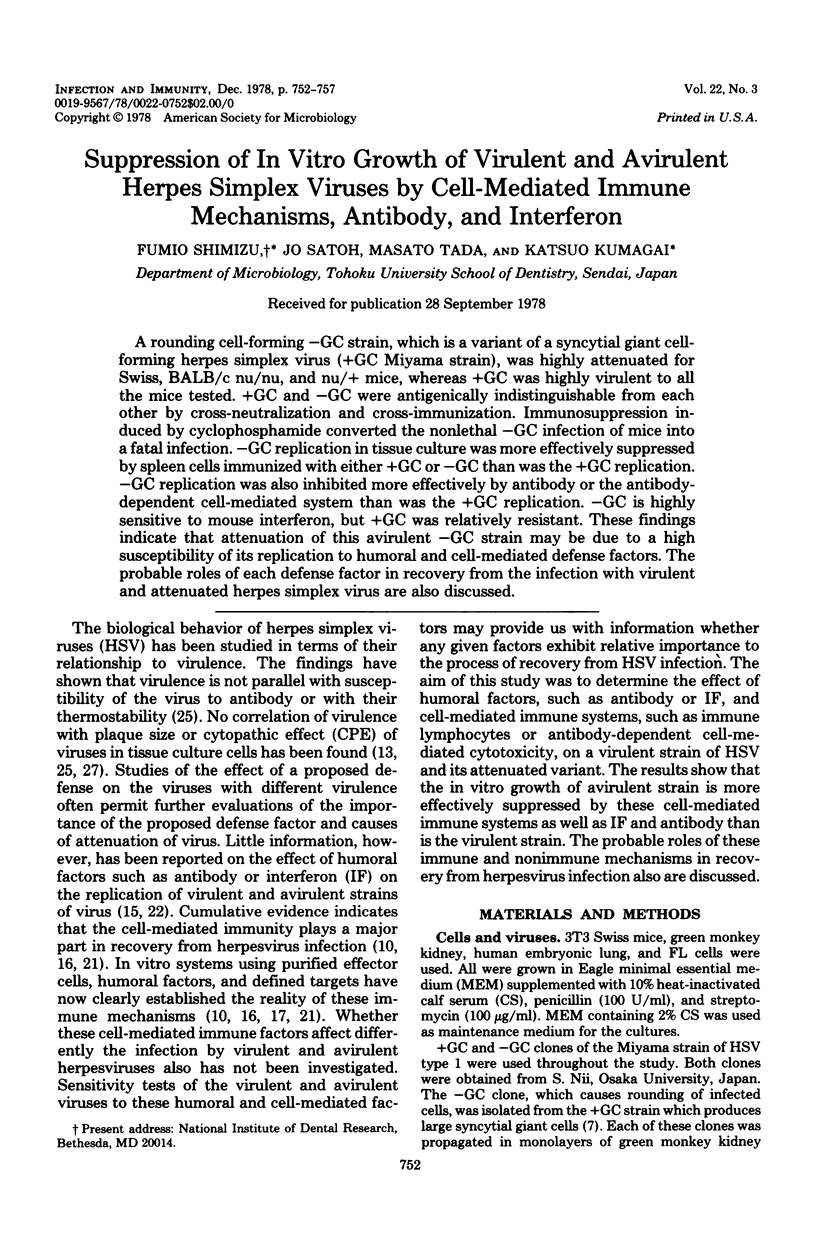
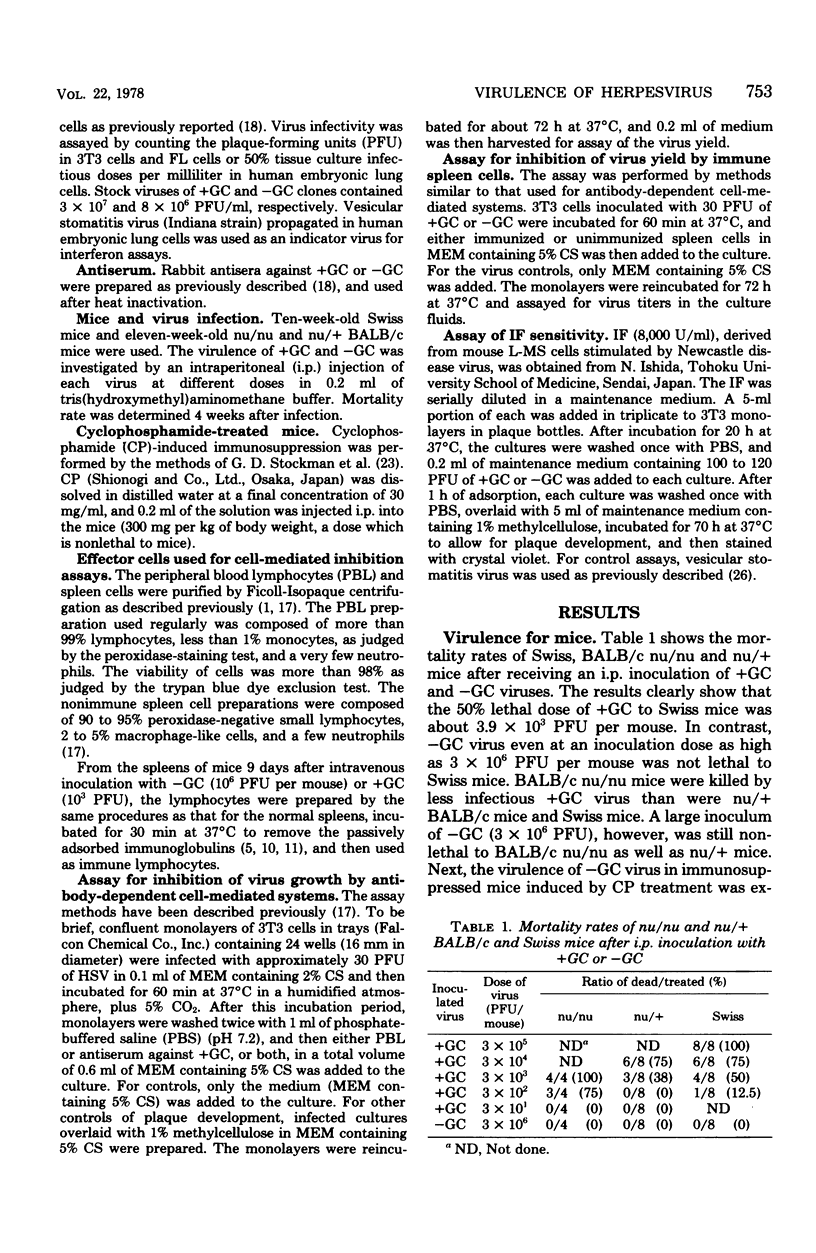
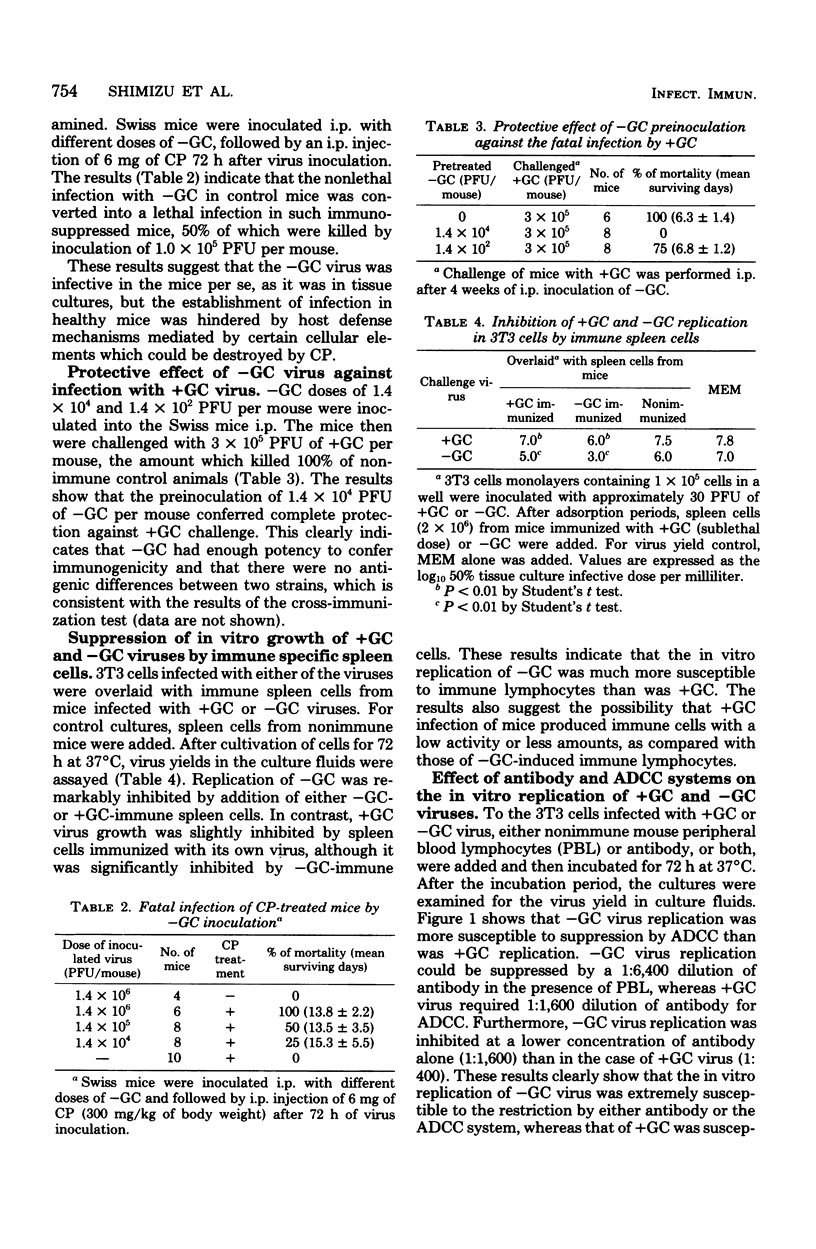
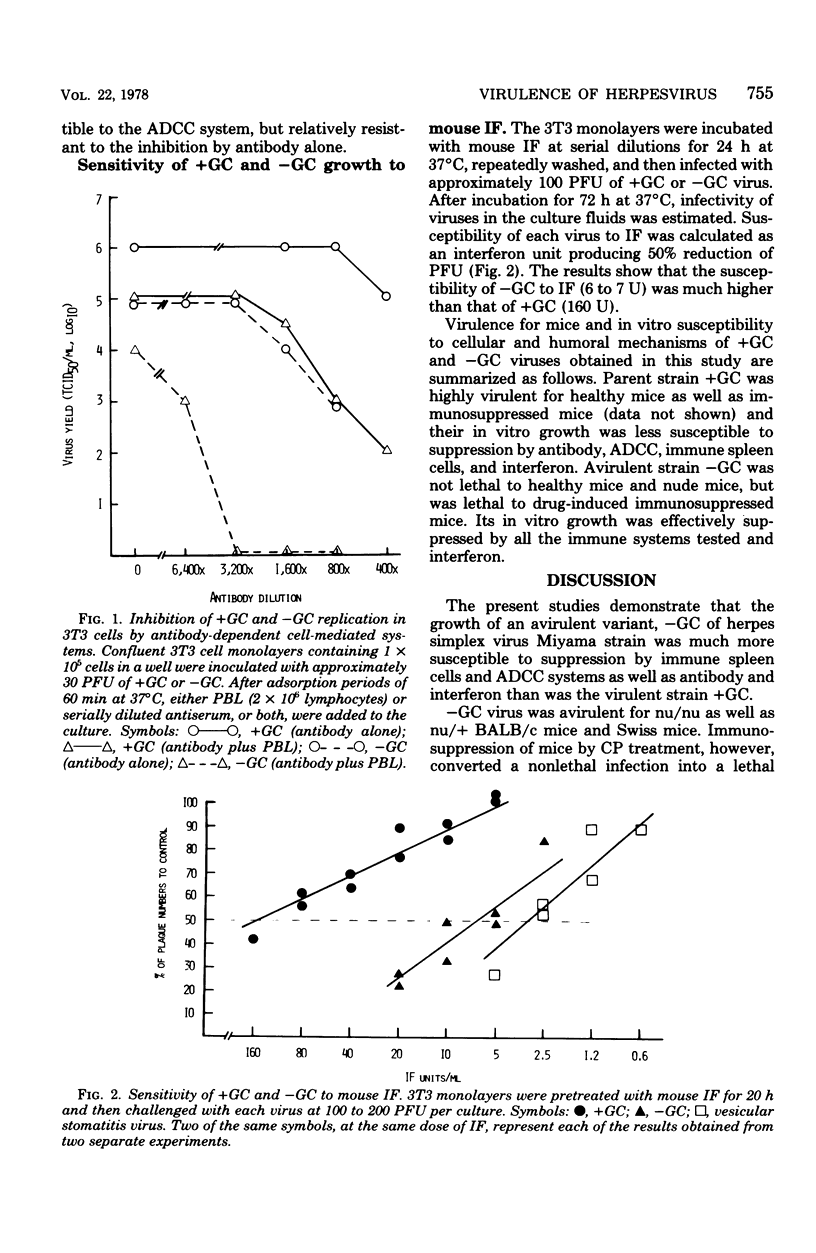

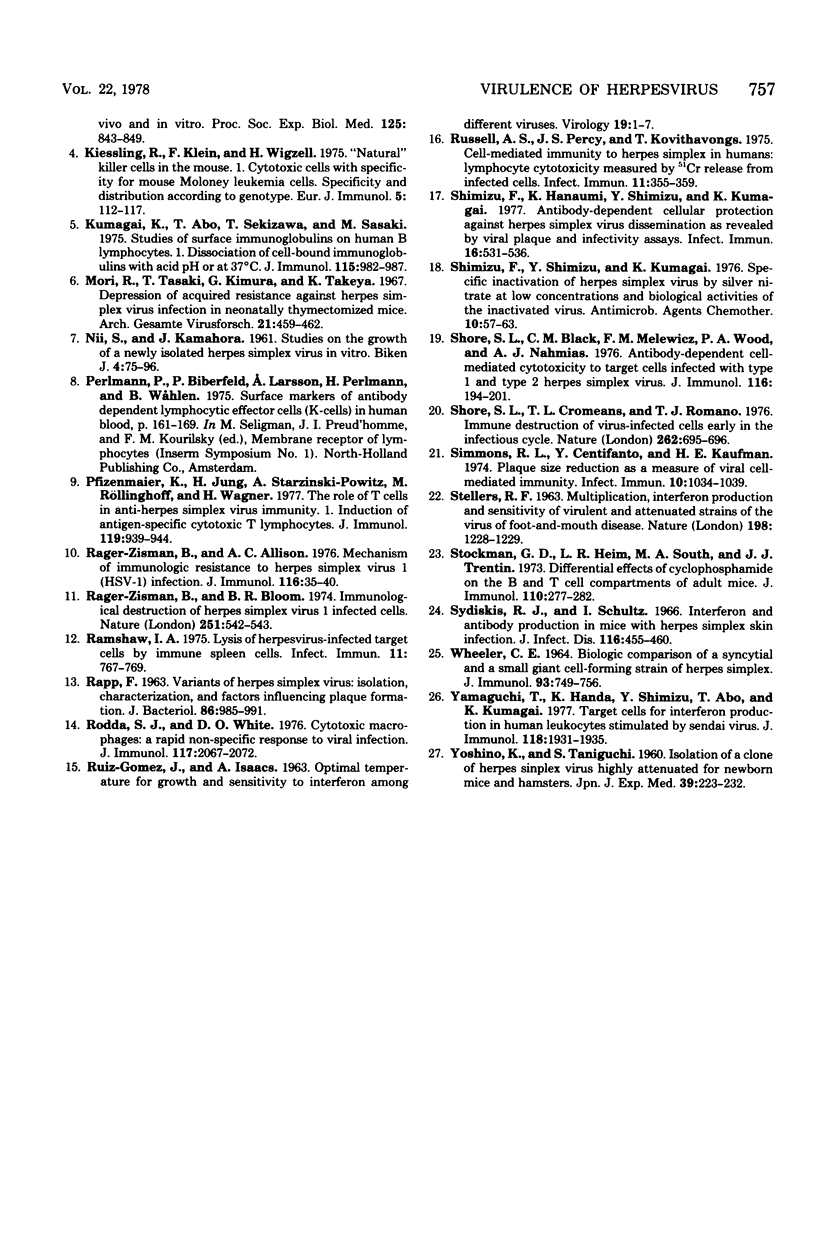
Selected References
These references are in PubMed. This may not be the complete list of references from this article.
- Abo T., Yamaguchi T., Shimizu F., Kumagai K. Studies of surface immunoglobulins on human B lymphocytes. II. Characterization of a population of lymphocytes lacking surface immunoglobulins but carrying Fc receptor (SIg-Fc+ cell). J Immunol. 1976 Nov;117(5 PT2):1781–1787. [PubMed] [Google Scholar]
- Ennis F. A. Host defense mechanisms against Herpes simplex virus. I. Control of infection in vitro by senstized spleen cells and antibody. Infect Immun. 1973 Jun;7(6):898–904. doi: 10.1128/iai.7.6.898-904.1973. [DOI] [PMC free article] [PubMed] [Google Scholar]
- Glasgow L. A., Hanshaw J. B., Merigan T. C., Petralli J. K. Interferon and cytomegalovirus in vivo and in vitro. Proc Soc Exp Biol Med. 1967 Jul;125(3):843–849. doi: 10.3181/00379727-125-32220. [DOI] [PubMed] [Google Scholar]
- Kiessling R., Klein E., Wigzell H. "Natural" killer cells in the mouse. I. Cytotoxic cells with specificity for mouse Moloney leukemia cells. Specificity and distribution according to genotype. Eur J Immunol. 1975 Feb;5(2):112–117. doi: 10.1002/eji.1830050208. [DOI] [PubMed] [Google Scholar]
- Kumagai K., Abo T., Sekizawa T., Sasaki M. Studies of surface immunoglobulins on human B lymphocytes. I. Dissociation of cell-bound immunoglobulins with acid pH or at 37 degrees C. J Immunol. 1975 Oct;115(4):982–987. [PubMed] [Google Scholar]
- Mori R., Tasaki T., Kimura G., Takeya K. Depression of acquired resistance against herpes simplex virus infection in neonatally thymectomized mice. Arch Gesamte Virusforsch. 1967;21(3):459–462. doi: 10.1007/BF01241745. [DOI] [PubMed] [Google Scholar]
- Pfizenmaier K., Jung H., Starzinski-Powitz A., Röllinghoff M., Wagner H. The role of T cells in anti-herpes simplex virus immunity. I. Induction of antigen-specific cytotoxic T lymphocytes. J Immunol. 1977 Sep;119(3):939–944. [PubMed] [Google Scholar]
- RAPP F. VARIANTS OF HERPES SIMPLEX VIRUS: ISOLATION, CHARACTERIZATION, AND FACTORS INFLUENCING PLAQUE FORMATION. J Bacteriol. 1963 Nov;86:985–991. doi: 10.1128/jb.86.5.985-991.1963. [DOI] [PMC free article] [PubMed] [Google Scholar]
- RUIZ-GOMEZ J., ISAACS A. Optimal temperature for growth and sensitivity to interferon among different viruses. Virology. 1963 Jan;19:1–7. doi: 10.1016/0042-6822(63)90017-5. [DOI] [PubMed] [Google Scholar]
- Rager-Zisman B., Allison A. C. Mechanism of immunologic resistance to herpes simplex virus 1 (HSV-1) infection. J Immunol. 1976 Jan;116(1):35–40. [PubMed] [Google Scholar]
- Rager-Zisman B., Bloom B. R. Immunological destruction of herpes simplex virus I infected cells. Nature. 1974 Oct 11;251(5475):542–543. doi: 10.1038/251542a0. [DOI] [PubMed] [Google Scholar]
- Ramshaw I. A. Lysis of herpesvirus-infected cells by immune spleen cells. Infect Immun. 1975 Apr;11(4):767–769. doi: 10.1128/iai.11.4.767-769.1975. [DOI] [PMC free article] [PubMed] [Google Scholar]
- Rodda S. J., White D. O. Cytotoxic macrophages: a rapid nonspecific response to viral infection. J Immunol. 1976 Dec;117(6):2067–2072. [PubMed] [Google Scholar]
- Russell A. S., Percy J. S., Kovithavongs T. Cell-mediated immunity to Herpes simplex in humans: lymphocyte cytotoxicity measured by 51-Cr release from infected cells. Infect Immun. 1975 Feb;11(2):355–359. doi: 10.1128/iai.11.2.355-359.1975. [DOI] [PMC free article] [PubMed] [Google Scholar]
- SELLERS R. F. Multiplication, interferon production and sensitivity of virulent and attenuated strains of the virus of foot-and-mouth disease. Nature. 1963 Jun 22;198:1228–1229. doi: 10.1038/1981228a0. [DOI] [PubMed] [Google Scholar]
- Shimizu F., Hanaumi K., Shimizu Y., Kumagai K. Antibody-dependent cellular protection against herpes simplex virus dissemination as revealed by viral plauqe and infectivity assays. Infect Immun. 1977 May;16(2):531–536. doi: 10.1128/iai.16.2.531-536.1977. [DOI] [PMC free article] [PubMed] [Google Scholar]
- Shimizu F., Shimizu Y., Kumagai K. Specific inactivation of herpes simplex virus by silver nitrate at low concentrations and biological activities of the inactivated virus. Antimicrob Agents Chemother. 1976 Jul;10(1):57–63. doi: 10.1128/aac.10.1.57. [DOI] [PMC free article] [PubMed] [Google Scholar]
- Shore S. L., Black C. M., Melewicz F. M., Wood P. A., Nahmias A. J. Antibody-dependent cell-mediated cytotoxicity to target cells infected with type 1 and type 2 herpes simplex virus. J Immunol. 1976 Jan;116(1):194–201. [PubMed] [Google Scholar]
- Shore S. L., Cromeans T. L., Romano T. J. Immune destruction of virus-infected cells early in the infectious cycle. Nature. 1976 Aug 19;262(5570):695–696. doi: 10.1038/262695a0. [DOI] [PubMed] [Google Scholar]
- Simmons R. L., Centifanto Y., Kaufman H. E. Plaque size reduction as a measure of viral cell-mediated immunity. Infect Immun. 1974 Nov;10(5):1034–1039. doi: 10.1128/iai.10.5.1034-1039.1974. [DOI] [PMC free article] [PubMed] [Google Scholar]
- Stockman G. D., Heim L. R., South M. A., Trentin J. J. Differential effects of cyclophosphamide on the B and T cell compartments of adult mice. J Immunol. 1973 Jan;110(1):277–282. [PubMed] [Google Scholar]
- Sydiskis R. J., Schultz I. Interferon and antibody production in mice with herpes simplex skin infections. J Infect Dis. 1966 Oct;116(4):455–460. doi: 10.1093/infdis/116.4.455. [DOI] [PubMed] [Google Scholar]
- WHEELER C. E., Jr BIOLOGIC COMPARISON OF A SYNCYTIAL AND A SMALL GIANT CELL-FORMING STRAIN OF HERPES SIMPLEX. J Immunol. 1964 Nov;93:749–756. [PubMed] [Google Scholar]
- Yamaguchi T., Handa K., Shimizu Y., Abo T., Kumagai K. Target cells for interferon production in human leukocytes stimulated by sendai virus. J Immunol. 1977 Jun;118(6):1931–1935. [PubMed] [Google Scholar]
- Yoshino K., Taniguchi S. Isolation of a clone of herpes simplex virus highly attenuated for newborn mice and hamsters. Jpn J Exp Med. 1969 Jun;39(3):223–232. [PubMed] [Google Scholar]


